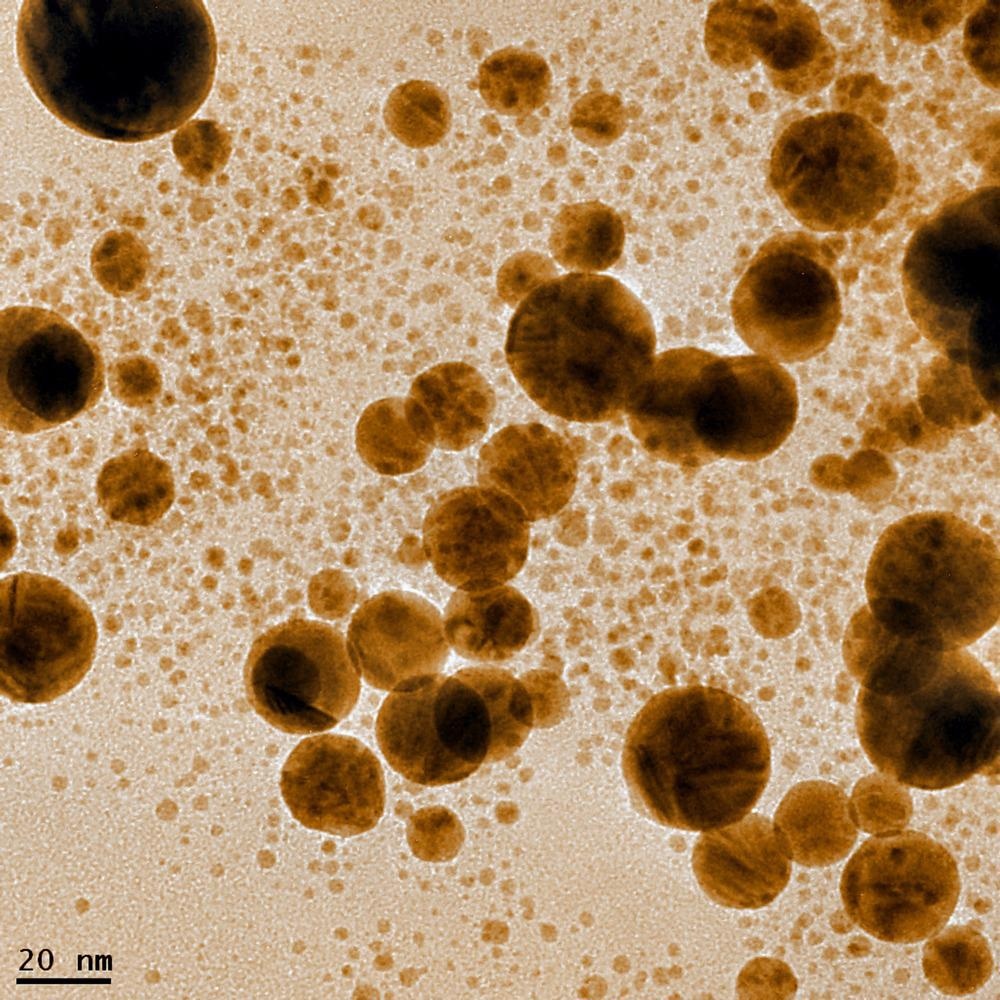.jpg) By Susha Cheriyedath, M.Sc.Reviewed by Skyla BailyNov 17 2021
By Susha Cheriyedath, M.Sc.Reviewed by Skyla BailyNov 17 2021A paper published in the journal ChemistrySelect discusses the production and applications of gold nanoparticles (Au NPs) that are distributed over graphene sheets using a green synthesis method that uses Kigelia Africana stem extract (KAE).

Gold Nanoparticles. Study: Studies on the Antioxidant and Antibacterial Activities of In Situ Green Synthesized Graphene-Gold Nanocomposite. Image Credit: Georgy Shafeev/Shutterstock.com
Latest advancements in nanotechnology have encouraged researchers to develop nanomaterials with unique characteristics that can be used as drug transporters to elevate the treatment efficiency and minimize the side effects of medicines.
A well-known carbon-based material called graphene has found several applications in the biomedical fields in the recent past, thanks to its excellent electrical, biological, thermal, and mechanical properties.
Techniques Involved in the Study
In the current work, the transformation from metal ions and graphene oxide (GO) into metal nanoparticles was facilitated by the reducing and stabilizing molecules in the stem of the KA plant. Techniques such as UV-Visible, X-ray diffractometry (XRD), infrared, scanning electron microscopy (SEM), Raman spectroscopy, and high-resolution transmission electron microscopy (HRTEM) were used to analyze the obtained graphene-gold nanocomposite.
KAE was used in the production of reduced graphene oxide-gold nanocomposite (KRG-Au NC) by the reduction of GO and gold ions. Also, total antioxidant activity (TAA), zone of inhibition (in mm), and DPPH radical scavenging activity against select bacteria were investigated for the antibacterial and antioxidant activity of KRG-Au NC.
During the research, the UV-visible spectra of the GO sample showed two absorption peaks—one at 235 nm and another at 303 nm. Once the GO and Au3+ ions were reduced by KAE to KRG-Au, the NC showed absorption at 279 nm and 556 nm.
More on Nanocomposites: Stereolithography with Vat Photopolymerization of Nanofiber Composites
This can be attributed to the restoration of extended conjugation in KRG due to the increased C=C double bonds. The absence of the shoulder at 303 nm was a result of the removal of oxygen functional groups.
Also, the absorption peak at 556 nm was ascribed to the surface plasmon resonance (SPR) band of Au NPs.
These alterations in UV-Visible absorption supported the formation of KRG-Au NC in the present protocol. The FT-IR spectrum of the KRG-Au NC, KRG, and GO showed prominent peaks of various oxygen-containing groups such as alkoxy, hydroxyl, epoxy, and carbonyl functional groups of GO. Reduction of GO with KAE resulted in several characteristic peaks appearing or disappearing with reduced intensity.
Results from Various Techniques Used
XRD analysis was carried out to confirm the formation of KRG-Au and the crystallinity of the NC. The GO peak’s XRD prototype was endorsed at a 2θ value of 11.22(002).
In KRG-Au NC, the particular peak faded significantly, and a new band was seen at 2θ of 24.6, close to unoxidized graphite. Furthermore, the diffraction patterns of KRG-Au NC revealed distinct peaks at 2θ values of 38.73, 44.82, 65.02, 77.98, and 82.03, which correspond to the (111), (200), (220), (311), and (222) crystal planes of Au NPs.
Further Reading: Tissue Regeneration with Magnetic Nanocomposites
The SEM investigation of the KRG-Au NC shows fully exfoliated graphene sheets randomly deposited with Au NPs. HR-TEM analysis was helpful to determine topography, structural information, and the Au NP distribution in the produced KRG-Au NC.
The HR-TEM images revealed stable graphene sheets and well-stabilized Au NPs, demonstrating that KAE was a good reduction reagent and stabilizer for KRG-Au NC. The degree of graphitization in KRG-Au NC was determined using Raman spectroscopy.
The formation of KRG-Au NC was confirmed using all the spectroscopic techniques, which illustrates that the phytochemicals in the KAE were effective reduction and stabilizing agents. The agar well diffusion method was used to test the antibacterial efficacy of KRG and KRG-Au NC against eight bacteria: four Gram-positive and four Gram-negative bacteria.
In situ Green Synthesis Particularly Suitable for Large-Scale Production of KRG-Au NC
In conclusion, a green approach was developed to produce KRG-Au NC using aqueous KAE in situ. The improved NC obtained using this protocol had a high yield (90%, 140 mg), was efficient, zero waste, and showed a random Au NP distribution on reduced graphene. UV-visible, XRD, FT-IR, HR-TEM, SEM, and Raman analyses were used to characterize the KRG-Au NC.
The KRG-Au NC exceeded ascorbic acid in terms of antioxidant property and showed potential antibacterial activity in comparison to streptomycin. Furthermore, the KRG-Au NC could be used as a free radical scavenger in pharmacological and biological applications.
This in situ green approach is particularly suitable for the large-scale synthesis of KRG-Au NC, with a wide range of potential applications in photocatalysis, catalysis, SERS substrate, and biosensors.
Disclaimer: The views expressed here are those of the author expressed in their private capacity and do not necessarily represent the views of AZoM.com Limited T/A AZoNetwork the owner and operator of this website. This disclaimer forms part of the Terms and conditions of use of this website.
Source:
Chandra Mohan Kurmarayuni, Basavaiah Chandu, Lakshmi Prasanna Yangalasetty, Siva Jyothsna Gali, Bala Murali Krishna Khandapu, Hari Babu Bollikolla. Studies on the Antioxidant and Antibacterial Activities of In Situ Green Synthesized Graphene-Gold Nanocomposite. ChemistrySelect. 2021. https://doi.org/10.1002/slct.202103236. https://chemistry-europe.onlinelibrary.wiley.com/doi/abs/10.1002/slct.202103236